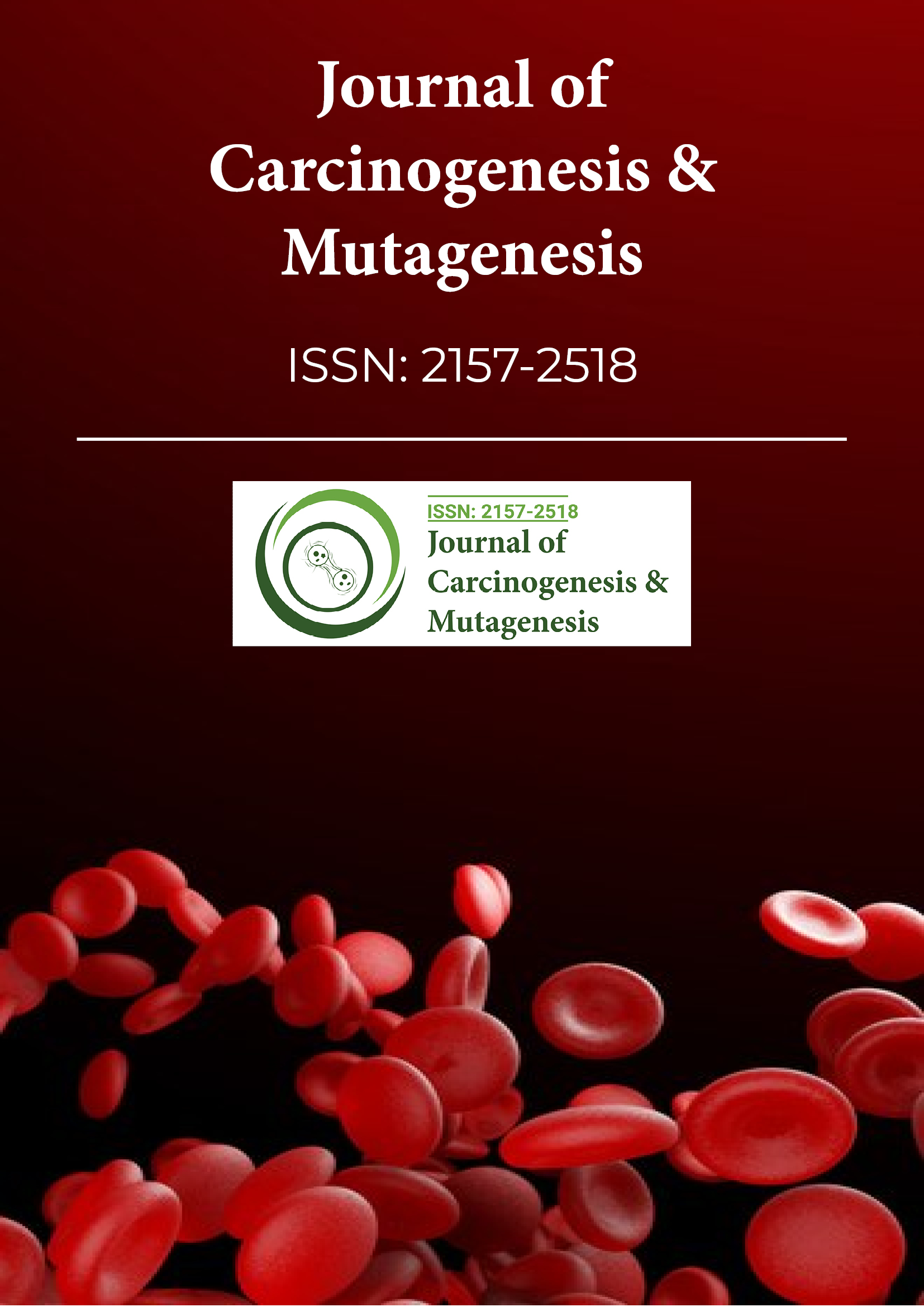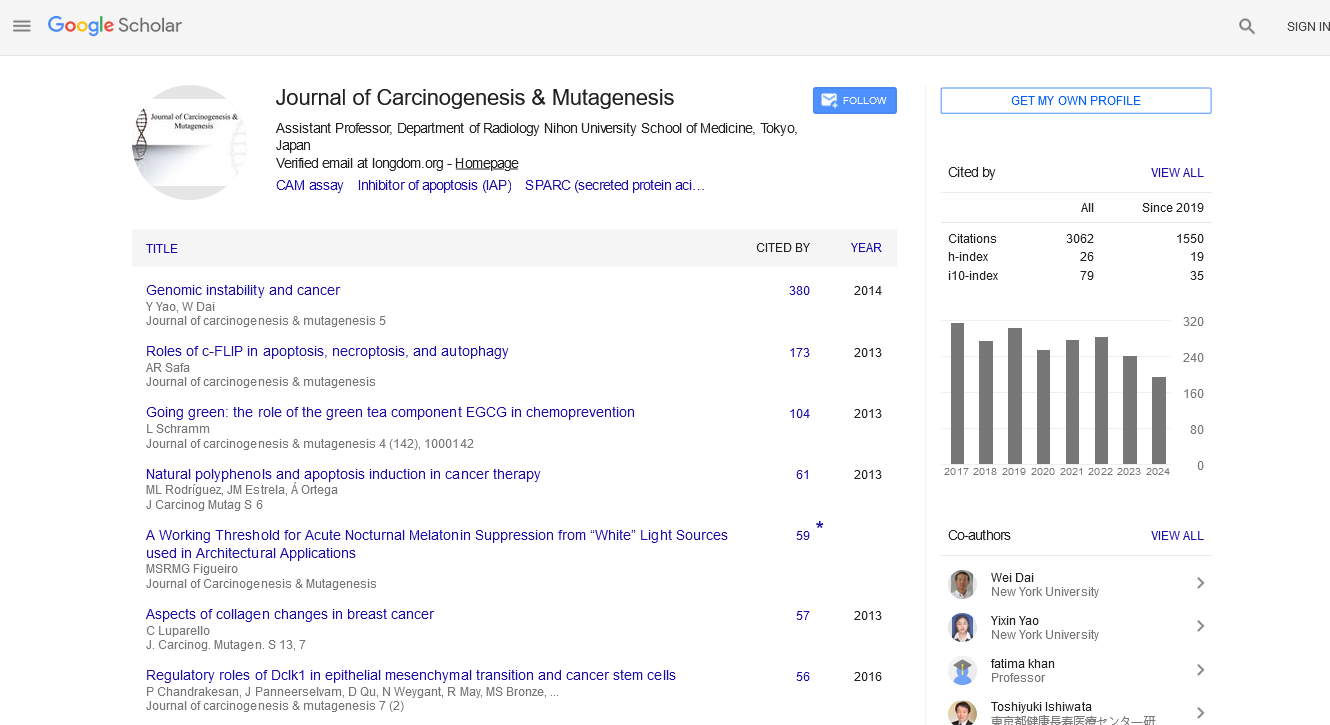PMC/PubMed Indexed Articles
Indexed In
- Open J Gate
- Genamics JournalSeek
- JournalTOCs
- Ulrich's Periodicals Directory
- RefSeek
- Hamdard University
- EBSCO A-Z
- OCLC- WorldCat
- Publons
- Geneva Foundation for Medical Education and Research
- Euro Pub
- Google Scholar
Useful Links
Share This Page
Journal Flyer

Open Access Journals
- Agri and Aquaculture
- Biochemistry
- Bioinformatics & Systems Biology
- Business & Management
- Chemistry
- Clinical Sciences
- Engineering
- Food & Nutrition
- General Science
- Genetics & Molecular Biology
- Immunology & Microbiology
- Medical Sciences
- Neuroscience & Psychology
- Nursing & Health Care
- Pharmaceutical Sciences
Commentary - (2023) Volume 14, Issue 4
Advancements in Gene Trap Mutagenesis and Genomic Discovery
Matteo Forloni*Received: 04-Jul-2023, Manuscript No. JCM-23-22896; Editor assigned: 06-Jul-2023, Pre QC No. JCM-23-22896(PQ); Reviewed: 20-Jul-2023, QC No. JCM-23-22896; Revised: 27-Jul-2023, Manuscript No. JCM-23-22896(R); Published: 04-Aug-2023, DOI: 10.35248/ 2157-2518.23.14.420
Description
Gene trap mutagenesis is a powerful and innovative technique used in molecular biology and genetics to uncover the functions of genes within an organism's genome. This method has revolutionized the field by allowing scientists to identify, study, and manipulate genes with unprecedented precision. In this comprehensive exploration of gene trap mutagenesis, we will delve into its principles, applications, and the remarkable insights it has provided into the intricate world of genomics.
Gene trap mutagenesis is a molecular genetics technique used primarily in model organisms, such as mice and fruit flies, to elucidate the function of genes in development, disease, and other biological processes. At its core, gene trap mutagenesis involves the insertion of a DNA element, often a gene trap vector, into a random location within the genome. This DNA element disrupts the function of the gene it integrates into, making it an invaluable tool for identifying genes and understanding their roles.
The key component of gene trap mutagenesis is the gene trap vector, a specially designed DNA construct engineered to insert itself into the host organism's genome. The promoter is a DNA sequence that drives the expression of a reporter gene, such as lacZ (beta-galactosidase) or Green Fluorescent Protein (GFP), when inserted into the genome. This element is responsible for identifying cells that have successfully integrated the gene trap vector into their genome. Common selectable markers include genes that confer resistance to antibiotics, such as neomycin or puromycin. The polyadenylation signal sequence ensures the termination of transcription and stabilization of the mRNA produced from the inserted vector.
The gene trap vector is introduced into the target cells or organisms, typically using methods such as electroporation, viral transduction, or microinjection. The gene trap vector integrates randomly into the host genome, often disrupting the function of an endogenous gene at the insertion site. Cells with successful vector integration are selected using the selectable marker, typically through exposure to the corresponding antibiotic.
Researchers assess the effects of gene trap vector integration on the host gene's function. This can involve various techniques, such as Reverse Transcription-Polymerase Chain Reaction (RTPCR), in situ hybridization, or immunohistochemistry.
Gene trap mutagenesis has a wide range of applications in biological research, making it an invaluable tool for uncovering the secrets of the genome. Gene trap mutagenesis facilitates the identification of novel genes by disrupting their function and allowing researchers to study the resulting phenotypic changes in the host organism. This technique helps elucidate the roles of known genes by studying the consequences of their disruption. Gene trap mutagenesis can be employed to create animal models of human diseases, allowing researchers to investigate disease mechanisms and test potential therapies. By disrupting specific genes during development, scientists can gain insights into the genetic underpinnings of embryonic development and tissue differentiation. Identifying genes that play a role in disease processes can lead to the development of targeted therapies.
Gene trap mutagenesis has prepared for numerous innovative discoveries in the field of genetics and molecular biology. Gene trap mutagenesis in mice has revealed vital genes involved in embryonic development, providing knowledge on the molecular mechanisms behind organ formation and tissue differentiation. This technique has helped identify genes implicated in various cancers, providing potential targets for therapeutic intervention. Gene trap mutagenesis has been instrumental in uncovering genes involved in immune system function, including those related to immune cell development and immune responses. By creating mouse models with disrupted genes associated with neurological disorders like Alzheimer's disease and autism, researchers have gained valuable insights into these complex conditions.
The integration of the gene trap vector into the genome is random, making it challenging to control the specific genes affected. Disrupting essential genes can lead to embryonic lethality or severe phenotypic effects, complicating the analysis. In some cases, phenotypic changes observed may not be directly related to the disrupted gene, leading to false conclusions.
Interpreting the effects of gene trap mutagenesis can be complex, requiring a combination of molecular techniques and thorough characterization of the resulting phenotypes.
As technology continues to advance, gene trap mutagenesis is evolving alongside it. Recent innovations, such as the development of inducible gene trap systems and more sophisticated reporter genes, have expanded the technique's utility and precision. Moreover, the integration of genome editing technologies like CRISPR-Cas9 with gene trap mutagenesis holds great promise for refining the targeting of specific genes.
Gene trap mutagenesis has emerged as a transformative tool in molecular genetics, enabling researchers to explore the intricate web of genetic interactions within an organism's genome. This innovative technique has led to the discovery of numerous genes and their functions, advancing our understanding of development, disease, and biology at large. As technology continues to advance, gene trap mutagenesis promises to remain at the forefront of genetic research, opening new doors to uncover the secrets of the genome.
Citation: Forloni M (2023) Advancements in Gene Trap Mutagenesis and Genomic Discovery. J Carcinog Mutagen. 14:420.
Copyright: © 2023 Forloni M. This is an open-access article distributed under the terms of the Creative Commons Attribution License, which permits unrestricted use, distribution, and reproduction in any medium, provided the original author and source are credited.


